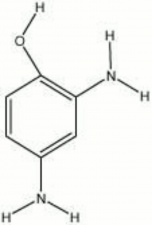Difference between revisions of "Amidol"
Jump to navigation
Jump to search
(username removed) |
(username removed) |
||
| Line 38: | Line 38: | ||
== Authority == | == Authority == | ||
| − | * | + | * Richard S. Lewis, ''Hawley's Condensed Chemical Dictionary'', Van Nostrand Reinhold, New York, 10th ed., 1993 |
| − | * | + | * Michael McCann, ''Artist Beware'', Watson-Guptill Publications, New York City, 1979 |
* ''The Merck Index'', Martha Windholz (ed.), Merck Research Labs, Rahway NJ, 10th edition, 1983 | * ''The Merck Index'', Martha Windholz (ed.), Merck Research Labs, Rahway NJ, 10th edition, 1983 | ||
Revision as of 06:25, 24 July 2013
Description
A colorless crystalline compound used as a photographic developer since 1892. Amidol, or diaminophenol hydrochloride, is also used to dye furs and hair.
Synonyms and Related Terms
acrol; diaminophenol hydrochloride; 2,4-diaminophenol dihydrochloride
Other Properties
Turns dark brown with age. Produces difficult to remove stains on most materials.
| Composition | C6H3(NH2)2OH-2HCl |
|---|---|
| CAS | 137-09-7 |
| Melting Point | 205 |
| Molecular Weight | mol. wt.=197.07 |
Hazards and Safety
Ingestion is toxic and may result in vertigo, convulsions and coma.
Inhalation and contact cause irritation and may produce an allergic reaction.
Fisher Scientific: MSDS
Authority
- Richard S. Lewis, Hawley's Condensed Chemical Dictionary, Van Nostrand Reinhold, New York, 10th ed., 1993
- Michael McCann, Artist Beware, Watson-Guptill Publications, New York City, 1979
- The Merck Index, Martha Windholz (ed.), Merck Research Labs, Rahway NJ, 10th edition, 1983
- Wikipedia, the free encyclopedia, at http://www.wikipedia.com Comment: http://en.wikipedia.org/wiki/Amidol (Accessed Mar. 20, 2006)
- The American Heritage Dictionary or Encarta, via Microsoft Bookshelf 98, Microsoft Corp., 1998
